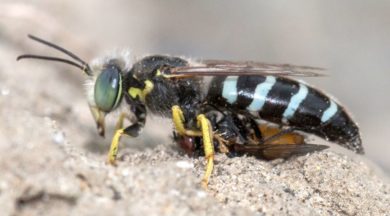September 2016 iNaturalist Vermont Photo-observation of the Month
Congratulations to Joshua Lincoln for winning the September 2016 iNaturalist Vermont photo-observation of the month contest. His image of a predatory Sand Wasp (genus Bembix) with a fly was the most popular photo-observation as measured by clicked 'favs'.

There are 21 species of these solitary wasps north of Mexico. Females use rakes made of hairs on their front legs to kick sand away while digging their nest. The female paralyzes flies with a sting and then brings them back to her nest. She lays an egg with the fly. Once the egg hatches, she will bring flies to feed it as needed. Once the larva is full-grown she seals the room shut and the larva spins a cocoon to pupate and overwinter. Meanwhile, males conduct dizzying and erratic flights just inches above the ground trying to detect virgin females as they leave their pupal chambers. Both are fueled by flower nectar.
Visit iNaturalist Vermont, a project of the Vermont Atlas of Life, and you can vote for the winner this month by clicking 'fav' on your favorite photo-observation. Make sure you get outdoors and record the biodiversity around you and submit your discoveries and you could be a winner this month!






